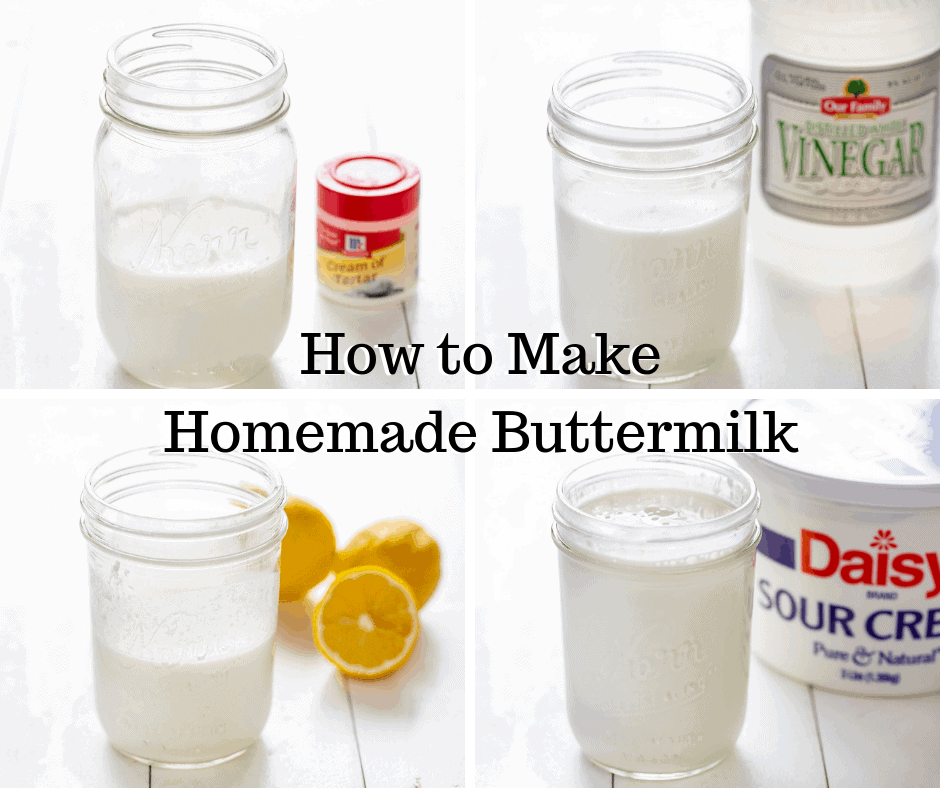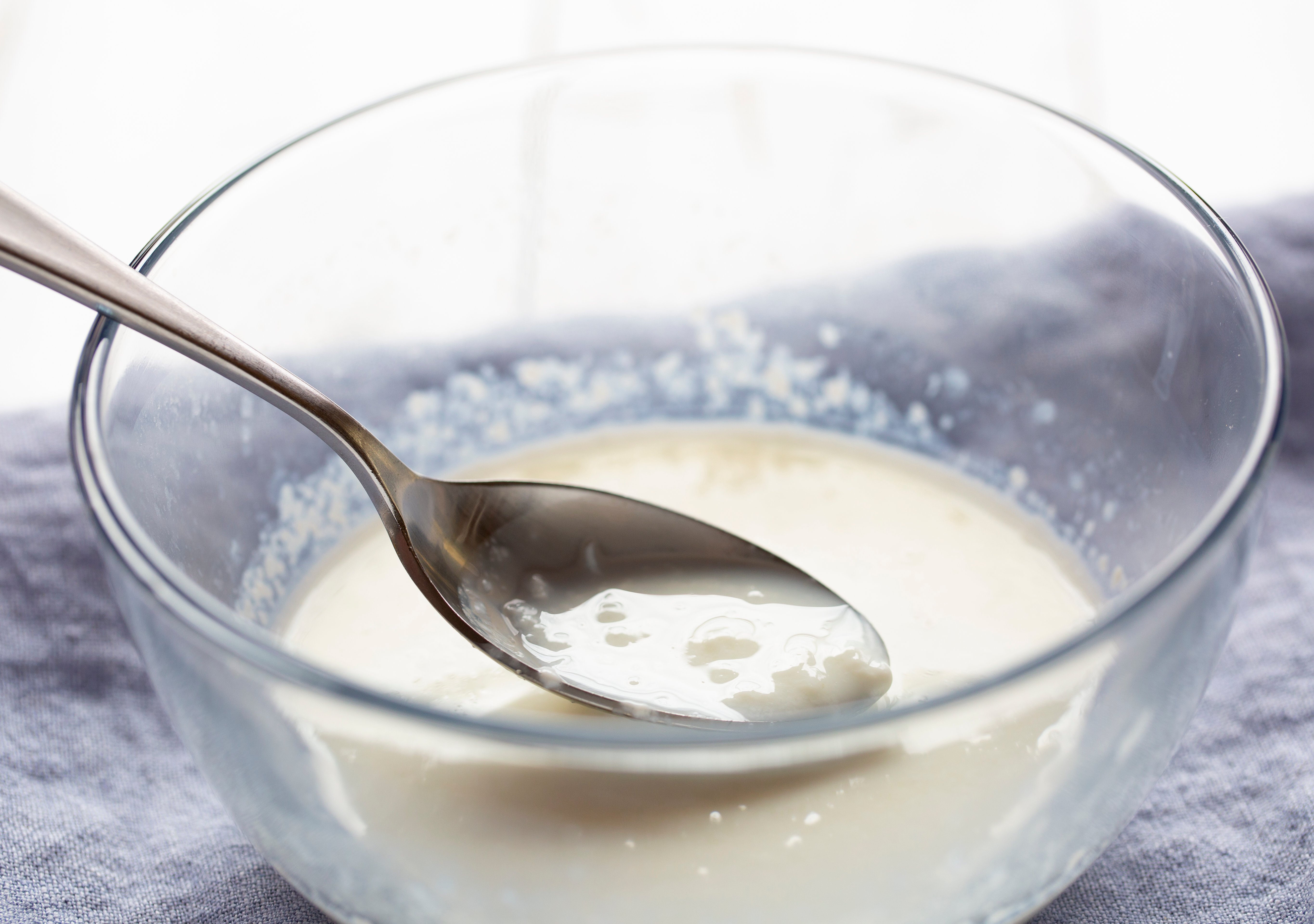Knowing how to make buttermilk can be a time saver as well as being more friendly on your pocketbook! You can make the exact amount you need for almost any recipe that calls for buttermilk! I tested out 4 different ways to make homemade buttermilk and can’t wait to share my findings with you! (If you scroll all the way to the bottom you can see where I tested these buttermilk recipes on my mile-high Buttermilk Biscuits!)

How to Make Buttermilk at Home
I have been baking for the last 15+ years and I have to tell you, I sure do feel foolish. I have been told time and time again to make homemade buttermilk you use 1 cup of milk and 1 tablespoon of vinegar or lemon juice. And that will replicate store-bought. I got to thinking… does it?
It all started with a simple taste test. I had some store-bought buttermilk on hand and I made up a cup of milk with vinegar and tasted each. What did I find? It tastes nothing like buttermilk nor does it measure up in texture and appearance. So why have I have making it this way for so long?
I set out to replicate store-bought buttermilk with the same standard ingredients. Milk + an acid. I was surprised to find out that 1 tablespoon is not enough. Two tablespoons were so much better! From this day on, if you ever need to make buttermilk at home, try adding 2 tablespoons of vinegar or lemon juice.
Why Use Buttermilk in Recipes?
Buttermilk brings a pleasant tang to cakes, bread, and biscuits. It helps tenderize gluten, giving baked goods a softer texture and more body. If baked goods have baking soda, then using buttermilk is a good option. Baking soda is a leavening agent that requires acidic ingredients such as buttermilk, lemon juice, or molasses to activate it.
The following variations of homemade buttermilk can be used in most recipes that call for buttermilk.

Vinegar Homemade Buttermilk Recipe
This is the classic, one that everyone knows. After testing the standard recipe I changed it up a bit:
1 cup room temperature whole milk + 2 tablespoons vinegar
Whisk the ingredients together until incorporated. Let sit for at least 10 minutes, up to 2 hours.
When I added 2 tablespoons versus 1, the consistency changed from thin milk to a thicker, chunkier (or curdled) version. But the most important reason I made the change was for taste. When I tasted the standard milk plus 1 tablespoon vinegar, I could barely detect it was there. When I added TWO tablespoons of vinegar, the flavor was much more consistent with tangy store-bought buttermilk.
Simply put, 2 tablespoons of vinegar help to best replicate the thick, creamy, tangy storebought buttermilk.

Lemon Juice Homemade Buttermilk Recipe
Probably the second most popular way to make buttermilk at home is with fresh lemon juice. Same as with the vinegar, I found that 1 tablespoon was not enough in a cup of milk. So, you guessed it, I tested using 2 tablespoons. I also tested using 3 tablespoons and found that it didn’t change the texture too much, but did add a bit of a lemony flavor. If you are making blueberry lemon quick bread or any recipe that would be complemented with a hint of lemon, you can certainly use 3 tablespoons in 1 cup of milk to create lemony homemade buttermilk! But for standard recipes calling for buttermilk, here is the formula.
1 cup room temperature whole milk + 2 tablespoons freshly squeezed lemon juice
Whisk the ingredients together until incorporated. Let sit for at least 10 minutes, up to 2 hours.
I didn’t have any store-bought lemon juice on hand so did not test its effectiveness.

Sour Cream Homemade Buttermilk Recipe
This version of homemade buttermilk is not as common, but it sure is good! I know that I am more likely to have sour cream on hand (every Tuesday is Taco Tuesday dontchaknow) than buttermilk, so this option is a good one. To make sour cream buttermilk you need:
1/2 cup room-temperature whole milk + 1/2 cup sour cream
Whisk the ingredients together until smooth and creamy. Let sit for at least 10 minutes, up to 2 hours.
When it came to replicating the flavor and texture of store-bought buttermilk, this recipe was the clear winner. It is thick. It is creamy. And it is tangy! I tried adding in an additional tablespoon of vinegar and liked that version even better, but my taste testers thought it was just a bit too much. If you like extra tang, you might want to try adding the additional vinegar too!

Cream of Tartar Buttermilk Recipe
This version of homemade buttermilk was not as familiar to me, and I didn’t have high hopes for it as I started testing. The recipe is simple:
1 cup room temperature whole milk + 2 teaspoons cream of tartar
Whisk the ingredients together until incorporated. Let sit for at least 10 minutes, up to 2 hours.
When you whisk the cream of tartar into the milk it disintegrates quickly leaving you with homemade buttermilk the texture of… milk. After letting this version sit for about 15 minutes, I poured it into a different container and found that the cream of tartar had almost solidified at the bottom of the jar. Make sure that if you use this version to WHISK WELL immediately before use.

Does the milk temperature matter?
In all the research I did no one mentions whether or not using warm milk or cold milk makes a difference. So I wanted to know, does it?

I did a simple test. In one bowl I added 2 tablespoons of vinegar to milk that I had heated in the microwave for 20 seconds. This version was instantly different; curdling and creating a thicker texture.

In the second bowl, I added 2 tablespoons of vinegar to cold milk. The vinegar didn’t seem to have the same effect on texture or thickness.
Conclusion: The warm milk version seemed to accept the acidity of the vinegar better, which makes perfect sense! We adhere to that rule (room temp ingredients) all the time in baking, why not apply it to our homemade buttermilk?
BUT MY TESTING WASN’T DONE THERE!
After doing all of this I wanted to know, does it make a difference in the final product? So, I whipped up a batch of my Buttermilk Biscuits. Well, four batches.

Here is what we discovered:
- Sour Cream – these biscuits were great, were as tall as they should be, and soft. This was my favorite version of homemade buttermilk as I love buttermilk biscuits to have a golden crust on top and be delicate and sweet inside.
- Cream of Tartar– this was a surprise, but it really shouldn’t have been! The biscuits were more of a cakey texture. Still tall and delicious, but not as distinguishable in the individual flakey layers. This makes perfect sense! We add cream of tartar to baked goods all the time as it helps cookies and cakes rise as well as produces carbon-dioxide gas bubbles that break gluten apart and make it soft. If you want a biscuit that will melt in your mouth, this is the version to try.
- Lemon Juice– these biscuits tasted great, were as tall as they should be, and had flakey layers. We saw no difference between these biscuits and the vinegar buttermilk biscuits.
- Vinegar – these biscuits tasted great, were as tall as they should be, and had flakey layers. We saw no difference between these biscuits and the lemon juice buttermilk biscuits.

In this picture, the order from left to right: sour cream, cream of tartar, lemon juice (I made 5 instead of 6, so it was bigger), and vinegar-based biscuits.

Homemade Buttermilk
Ingredients
Vinegar Buttermilk
- 1 cup whole milk, room temperature
- 2 tablespoons vinegar
Lemon Juice Buttermilk
- 1 cup whole milk, room temperature
- 2 tablespoons fresh lemon juice
Sour Cream Buttermilk
- ½ cup whole milk, room temperature
- ½ cup sour cream
Cream of Tartar Buttermilk
- 1 cup whole milk, room temperature
- 2 teaspoons cream of tartar
Instructions
Vinegar Buttermilk
- Whisk the ingredients together until incorporated. Let sit for at least 10 minutes, up to 2 hours.
Lemon Juice Buttermilk
- Whisk the ingredients together until incorporated. Let sit for at least 10 minutes, up to 2 hours.
Sour Cream Buttermilk
- Whisk the ingredients together until smooth and creamy. Let sit for at least 10 minutes, up to 2 hours.
Cream of Tartar Buttermilk
- Whisk the ingredients together until incorporated. Let sit for at least 10 minutes, up to 2 hours.
Video
Did you make this recipe?
Thank you for making my recipe! You took pictures, right? Well go ahead and post them on Instagram! Be sure to mention me @iambaker and use the hashtag #YouAreBaker.
Final conclusion?
All four recipes for homemade buttermilk work! Just be sure you try adding TWO tablespoons next time you make the vinegar or lemon juice version. 🙂
And while they all seem to work beautifully, they do seem to produce different results. But not enough that anyone would notice! We were scrutinizing every detail and that’s how we came to our conclusions, but if you were serving any of these to friends and family they would only have one reaction… “that’s a great biscuit!”











These recipes will do when you need some quickly. If you want the real thing and it can’t be found at the supermarket, you can make that, too. It takes about 8 to 12 hours. You need a small cooler big enough to hold two quart Mason jars. Get some starter such as Lactococcus lactis or Lactobacillus bulgaricus, available from Amazon and other places. Use their directions–usually involves putting some starter in the jar, filling it with milk, placing in cooler with jar lid laying loosely on top of jar. Fill cooler with 80 deg tap water up to just below the neck of the jar. Replace water when it drops to 70 deg–only need to do that once. When finished incubating, tighten lids and place in fridge until cold. You can keep making it without buying any more starter–just use 1/4 cup buttermilk instead.
I have to eat dairy free, and have used both the vinegar and lemon version with room temperature coconut milk. It also works great. After reading this, I will increase the amount of lemon or vinegar I use! Thanks, love your tips and recipes!!
Can these options be added to Lactose Free Milk?
Do you have to use whole milk or will 2% do?
Tell me about butter milk pancakes? With Bisquick ?
Girl
I’m tellin’ you, as old folks used to say ‘You are getting down to brass tacks’. I’m a home cook from Alberta Canada. Probably old enough to be your grandma but I am sooo impressed with your site already and I just got here 🙂 .
Will pass along your site info. to my other friends who love to cook too.
Thank you